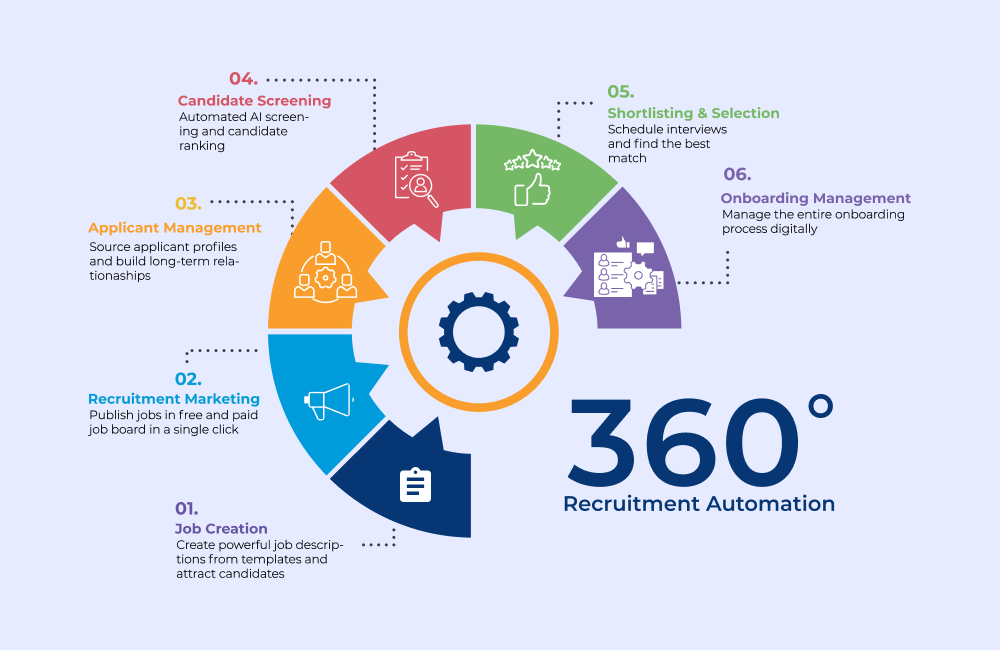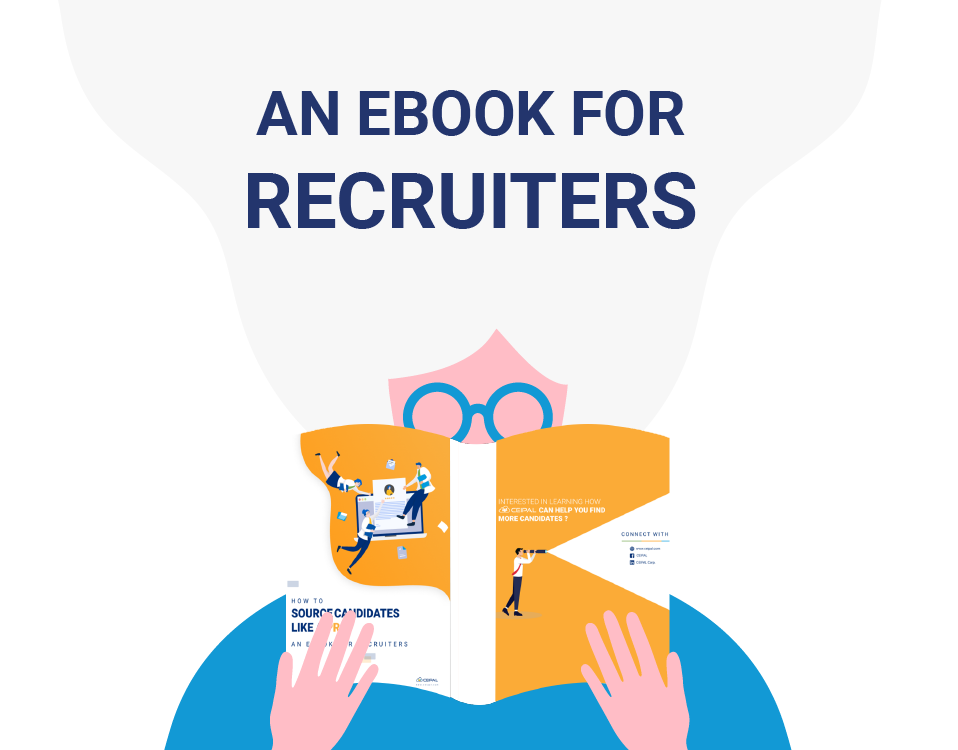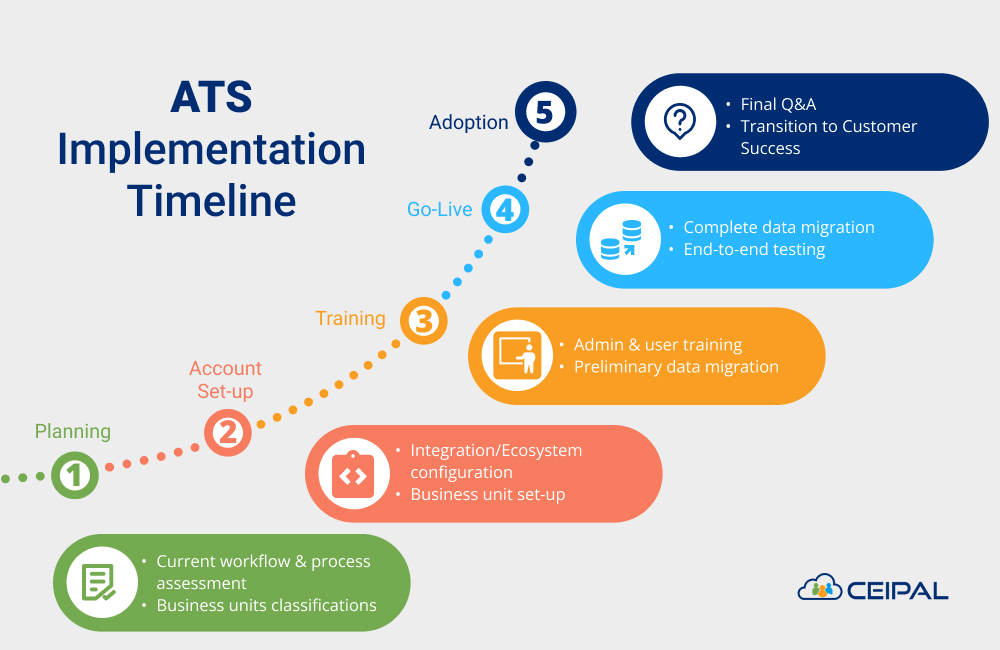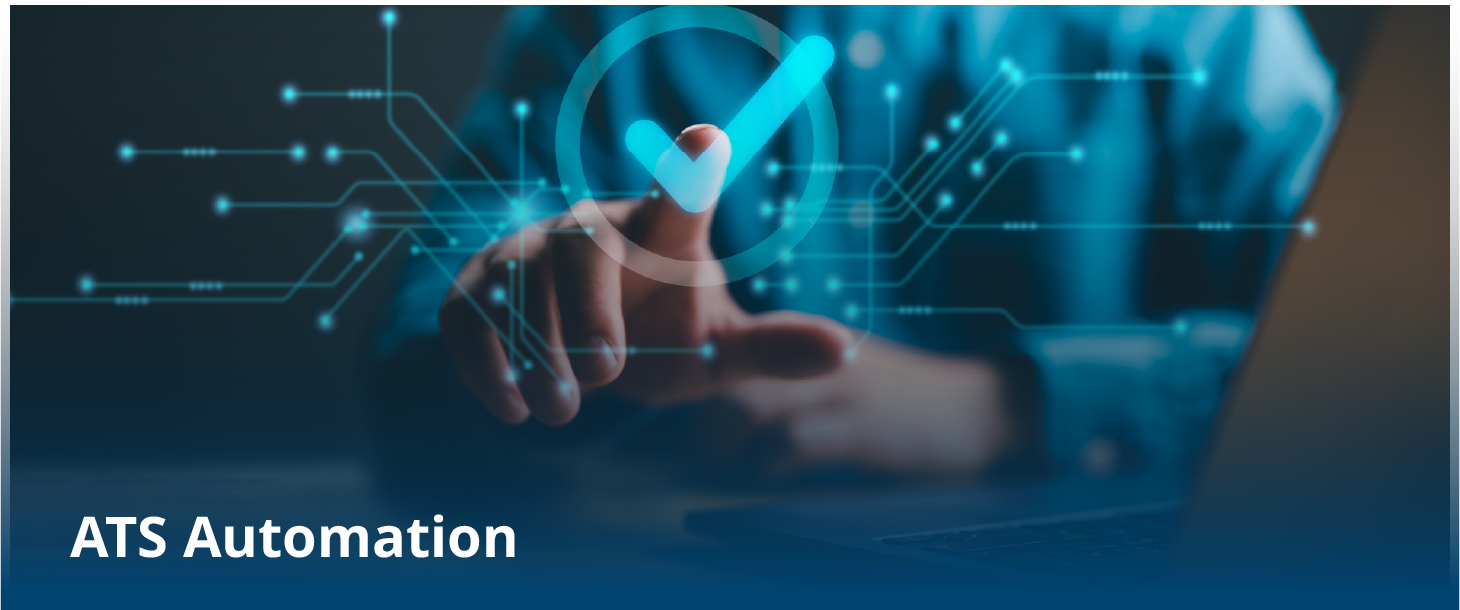What is an Applicant Tracking System?
Applicant Tracking Systems (ATS) are intelligent, scalable recruitment software for HR and staffing professionals. ATS systems seamlessly automate recruitment processes and allow hiring managers to source, shortlist, and select the right candidates. In other words, ATS is like an applicant data repository that can be used to automate workflows and maintain compliance all along the recruitment process.
ATS Systems are built with the sole purpose of making the life of recruiters and hiring managers easier by automating every mundane and monotonous task. Powerful ATS has the ability to automate the entire recruitment life-cycle, starting the moment a job requirement is posted to the job board to onboard the candidate.
What Does an ATS Do?
Applicant Tracking Systems provide a wide range of capabilities, including parsing thousands of resumes, storing applicant data, ranking candidates, onboarding them, etc. Requirements for each organization vary deeply. Organizations cannot invest in third-party sites every time they have new hiring requirements. ATS systems are known for streamlining a recruiter’s workflow by using a single platform for every task.
- Sourcing Candidates. Sourcing talent is one of the biggest challenges faced by almost every organization. To deal with the ongoing talent shortage, most companies opt for a diversified candidate pool from numerous channels-
- Job Boards
- Social Media
- Niche Sites
- Employee Referrals
- Offline Events
An ATS helps recruiters keep a track of applicants from every source and details of the channels. This lets hiring managers identify success rates and plan for better hiring results.
- Candidate Shortlisting. A good ATS features high searchability that combines both Natural Language Processing (NLP) and AI algorithms to provide extraordinary “profile matching” ability. These systems use semantic keyword matches to rank candidates for each profile, thereby reducing almost 70% of a recruiter’s task.
- Database Management. Every hiring team keeps track of each resume that comes into the system. But unfortunately, highly qualified talents get buried in piles of excel sheets and paperwork, causing hiring teams to lose out on hundreds of candidates. An ATS can store all this information in a way that is updated in real-time, provides amazing searchability, and can be used to source amazing candidates.

Benefits of Using an Applicant Tracking System
- Eliminate Administrative Tasks. ATS systems ensure the complete elimination of paperwork and manual tasks. With many organizations moving to remote settings the need for recruitment software has grown dramatically.
- Centralized Job Marketing. A SaaS-based centralized system lets recruiters publish jobs to multiple free and paid job boards from a single place. Hiring managers can keep track of every applicant’s information based on their source. They can then optimize their spending based on the success rates of each source.
- Save Cost-per-Hire. Automation saves almost 70% of a recruiter’s time. With good time at hand, recruiters can focus on what is most important: finding quality candidates. With fewer human hours to count for, organizations can save up to 40% on their hiring costs.
- Boost Speed-of-Hire. Since everything repetitive is managed by an applicant tracking system, they can increase a recruiter’s productivity. This automation helps recruiters to make data-driven decisions which lead to smarter and shrink the amount of time it takes to make a hiring decision.
- Enhanced Reporting and Analytics. Most organizations struggle with creating collaboration among teams. An applicant management software allows visibility of the entire system. With visibility, teams function with high efficiency, and no candidate is lost due to a lack of team efficiency.
- Better Candidate Experience. Almost 80% of the candidates do not finish the job application process. Lengthy application processes make the applicants bored, causing staffing teams to lose out on amazing talents. ATS systems capture data quickly and shorten the application processes, which creates a positive candidate experience.
- Higher Quality-of-Hire. Even though the quality of hire is subjective to the organization and its expectations, highly qualified candidates are in the job market for a very short period. With Applicant Tracking Software, it is possible to speed up the recruitment process. Using a combination of this dynamic process and a candidate repository, it is easier to retain higher-quality candidates.
Why Do Companies Need an ATS?
If you are using only Gmail, Excel Spreadsheets, and Zoom meetings in remote settings to manage job applications, shortlist, candidate interviews, offer management, and the onboarding process, it will eventually become overwhelming. Forcing your recruiters to redundant and time-consuming tasks instead of automating the process to deliver an amazing candidate experience. An ATS is not just another piece of software. If you want to scale your staffing team and business, it’s time to invest in an Applicant Tracking System. Before you start to look for an Applicant Tracking System, here are a couple of organizational things your need to figure out first-
- Understand your business’ unique problems
- Your budget for a recruitment software
- Resources size and capabilities of your organization
- Expectations from an external software vendor
Once your goals are clear and established, you can move on to your quest for finding the best Applicant Tracking System that fits your organization. Here are a few things you need to keep in mind while searching for an ATS-
- Does the ATS cater to your business size, industry, or geography?
- Have you taken multiple demos and free trials?
- Checked out third-party reviews?
- Does the ATS resolve your unique problem?
- Is the ATS system customizable?
- Do you need training every time you expand your team?
- What does the implementation timeline look like?
- Does the ATS provider give full-time customer support?

Want to Source Candidates Like a Pro?
Read an eBook Designed for Smart Recruiters Like You
Top 11 Features of ATS
1. Job Management
Job management includes everything job requirement related. It starts by curating a job description that describes the responsibilities, sends out the brand messaging, talks about the inclusivity of the organization, etc. ATS systems are great because they have in-built job templates which can be used by recruiters to easily create amazing job descriptions. Once a job requirement is created in the system, the next step is to publish it in multiple channels to attract candidates. Most ATSs allow single-click job posting on desired free and paid job boards, social media sites, etc.
2. Applicant Management
Candidates can enter into the system from numerous channels (manual submission by recruiters, candidate submission via email, job board, social media sites, career pages). An ATS talent pipeline organizes active candidate data and maps them to job openings and the stages of recruitment. With a highly consolidated view, recruiters can easily access any candidate’s information that comes into the system and ensure zero duplicacy and clutter. Most ATS platforms aggregate huge databases of active and passive candidates. Due to high searchability capabilities, recruiters can easily source candidates from the vast pool of candidates.
3. Resume Parsing
Resume parsing refers to automated storing, organizing, and conversion of unstructured candidate information into a structured format for easy machine readability. A recruiter spends a lot of time just going through hundreds of resumes to find one good candidate. This not only exhausts the recruiter, but the information collected from resumes/CVs may not be properly stored. Every time the recruiter has a requirement, he has to go through hundreds of resumes once again.
4. AI Candidate Ranking
When the AI candidate ranking feature is added to an Applicant Tracking System, it lets you automatically find the most relevant candidates for any given position by running profile-matching algorithms. Not only does it evaluate the candidates’ resumes based on keywords and skill-match, but it also correlates the cultural compatibility of the candidates and ranks them. Recruiters can apply multiple filters like current employment status, location, willingness to relocate, educational qualifications, skills, and experience.
5. Recruitment CRM
While ATS is an applicant data repository, recruitment CRM enables recruiters to nurture and engage with candidates and clients to build long-lasting talent communities which can help the organization to future proof hiring needs. Using a Recruitment CRM, you can create responsive email campaigns and configure workflows with in-built trigger actions and outreach templates. It also lets you enhance your overall candidate and client communication via personalized calls, text messages, and email. CEIPAL’s recruitment CRM allows you to nurture prospects and clients’ pipelines and helps to maximally increase recruitment sales revenue.
6. Integrations
This is one of the most important things to look at before you invest in an ATS. Integrations are extremely crucial to optimizing+ the hiring process. Applicant Tracking systems across the globe provide a variety of integrations with job boards, job aggregators, niche job sites, productivity apps plugins, video and interview platforms, assessment platforms, calendars, e-signature platforms, HRIS systems, Recruitment CRM, Vendor Management Systems (VMS), etc. ATS systems must connect with every tool that a recruiter uses. With all the apps synced into one, the data is not scrambled. This eliminates hours of manual data entry and duplication.
7. Employer Branding Capabilities
Cold calling an applicant is a trial and error method but includes more errors. Most recruitment agencies and teams are focused on attracting candidates by deploying multiple recruitment marketing strategies rather than getting let down by spending tons of money. A good ATS provides career site integrations that enable recruiters to convert the website traffic into successful employees of the organization. Employers can showcase their Employee Value Proposition (EVP) across each stage of the recruitment process. Some of the employer branding efforts include- job description inclusivity, showcasing the culture of the organization in career pages & social media posts, employee testimonials, etc.
8. Candidate E-onboarding
Many ATS systems let you automate the entire onboarding process, including document collection, storing, and e-signatures. Losing a candidate at the onboarding stage can cost the organization a lump sum of money. Onboarding new candidates require accurate due diligence, compliance, and careful implementation keeping all while delivering an incredible candidate experience. In-built onboarding software in an Applicant Tracking System makes the transition of a candidate to an employee using a customized checklist of documents, automated email notifications, etc to make the process seamless.
9. Enhanced User Experience
Recruiters are the end users of an Applicant Tracking System. An ATS system may have every possible amazing feature required, but if it is not easy to navigate or creates confusion for the users, it only results in wasting time. A good ATS should have an appealing look, provide easy navigation to tools, and be optimized for mobile. While recruiting new hiring teams, it is easier to train them if the Applicant Tracking System is highly intuitive, navigational, and has better UX. With organizations opting for remote settings, the need for onboarding software has become even more important.
10. Mobile Recruitment
To stay competitive in the staffing business, your recruitment software should not restrict your recruiter to their desk. Whether it is publishing a job form to an MSP, texting a candidate, or responding to a client submission, a recruiter should be able to do that anytime, anywhere without being tethered to their desktop computer. Mobile recruiting is all the rage. When you expect a certain standard of productivity among recruiters, it is only reasonable that you provide your hiring teams and managers with the tools they need to hire talent faster.
11. Intelligent Reporting and Dashboards
Investing in any software today is absurd if the activities and performance of the users are not being tracked. Role-specific dashboards (recruiters, hiring managers, executives, and sourcing specialists) are one of the most common dashboards used by hiring teams which allows user-specific configurations made by the admin. Recruiters and hiring managers can also generate reports based on sourcing, engagement, talent pipeline, and other available modules, which can help in making data-driven hiring decisions and make them actionable.
Implementing an Applicant Tracking System
A lot of work goes into shortlisting and selecting the right Applicant Tracking System (ATS) for your organization, with multiple stakeholders (Talent Acquisition, Procurement, HR, Finance) giving their inputs at each level. But, once you have selected the software, the real work begins. Implementation of the Applicant Tracking System involves heavy data collection and migration, all while maintaining compliance and security requirements. ATS implementation for small and medium-sized companies can be done within 3-4 weeks, but for enterprises, it may go on for months. The implementation timeline varies according to requirements and customizations, and resources involved.

ATS Checklist
| Staffing Agency | SMBs | Enterprise | |
|---|---|---|---|
| Free Trial | |||
| Job Board Management | |||
| Candidate Sourcing | |||
| Resume Parsing | |||
| Candidate Ranking | |||
| Talent Pipeline Tracking | |||
| Bulk Messaging/ Emailing | |||
| Career Portal | |||
| Developer API | |||
| Employee Referral Portal | |||
| Automated Interview Scheduling | |||
| Calendar Integration | |||
| Custom Dashboards | |||
| Integrations | |||
| Campus Hiring | |||
| Chatbot Recruitment | |||
| Background Verification | |||
| Mobile Recruitment | |||
| Candidate E-Onboarding | |||
| Offer Management | |||
| Data Security & Compliance | |||
| Customer Support |







